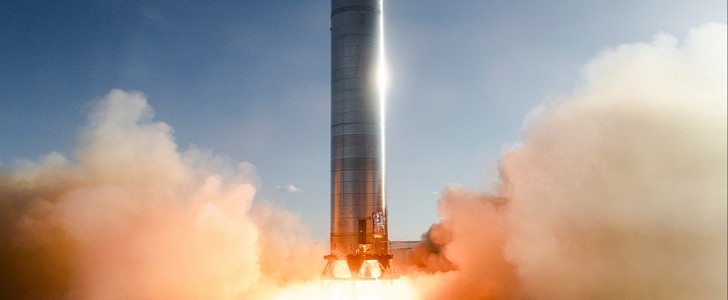On Monday, July 19th, SpaceX fired up for the first time the massive Super Heavy booster rocket in a static fire test for the new Starship spacecraft. Although it lasted a few seconds, the test was successfully completed, proving that preparations are underway for Starship's first orbital launch.
SpaceX's Starship system is a reusable transportation system designed for missions to the Moon and Mars as well as Earth's orbit. Composed of a two-stage vehicle which includes the Super Heavy rocket (booster) and the Starship (spacecraft), the system is powered by sub-cooled methane and oxygen.
Booster 3, as this specific Super Heavy is known, was completed earlier this month and is the first fully working Super Heavy prototype to be relocated to the launch site and put through a series of testing.
On Monday, July 19th, the stainless-steel booster fired three Raptor engines in a short static fire test at SpaceX's South Texas launch site located near Boca Chica.
"Full duration firing of 3 Raptors on Super Heavy Booster," SpaceX CEO Elon Musk said on Monday. While Musk previously stated that Rocket 3 will not be launched into space, Booster 4 will be the first booster to take off into orbit, together with Starship 20 (the first orbital Starship vehicle).
When a Twitter user asked him about the chances of more tests with the rocket, he responded that "depending on progress with Booster 4, we might try a 9 engine firing on Booster 3."
While nine engines may seem like a lot, it would not be the first time the company has used that many. SpaceX Falcon rocket's first stage is composed of three Falcon 9 nine-engine cores whose 27 Merlin engines generate together more than five million pounds of thrust at liftoff. By comparison, a fully orbital version of Super Heavy Booster will have 33 engines.
Much of the Starship 20 rocket is already completed. On June 25th, SpaceX president Gwynne Shotwell has stated in an interview for the National Space Society's International Space Development Conference (ISDC) that the company is "shooting for July" for its first orbital launch. There are less than two weeks left in the month, so we'll simply have to wait and see if the company meets its goal.
Booster 3, as this specific Super Heavy is known, was completed earlier this month and is the first fully working Super Heavy prototype to be relocated to the launch site and put through a series of testing.
On Monday, July 19th, the stainless-steel booster fired three Raptor engines in a short static fire test at SpaceX's South Texas launch site located near Boca Chica.
"Full duration firing of 3 Raptors on Super Heavy Booster," SpaceX CEO Elon Musk said on Monday. While Musk previously stated that Rocket 3 will not be launched into space, Booster 4 will be the first booster to take off into orbit, together with Starship 20 (the first orbital Starship vehicle).
When a Twitter user asked him about the chances of more tests with the rocket, he responded that "depending on progress with Booster 4, we might try a 9 engine firing on Booster 3."
While nine engines may seem like a lot, it would not be the first time the company has used that many. SpaceX Falcon rocket's first stage is composed of three Falcon 9 nine-engine cores whose 27 Merlin engines generate together more than five million pounds of thrust at liftoff. By comparison, a fully orbital version of Super Heavy Booster will have 33 engines.
Much of the Starship 20 rocket is already completed. On June 25th, SpaceX president Gwynne Shotwell has stated in an interview for the National Space Society's International Space Development Conference (ISDC) that the company is "shooting for July" for its first orbital launch. There are less than two weeks left in the month, so we'll simply have to wait and see if the company meets its goal.
First static fire test of Super Heavy booster pic.twitter.com/JtvGMfTgPj
— SpaceX (@SpaceX) July 20, 2021






